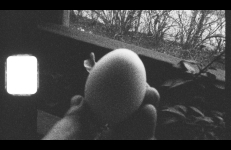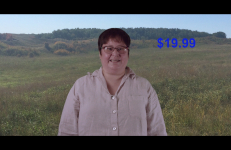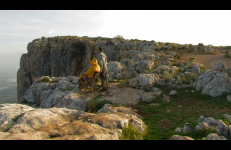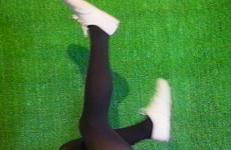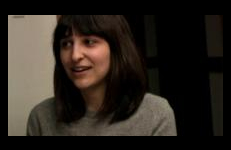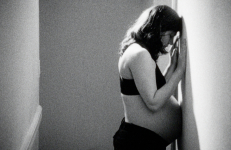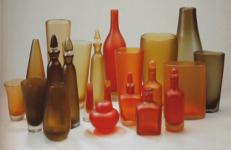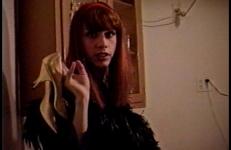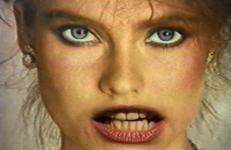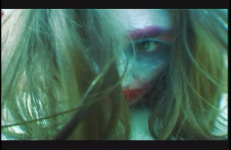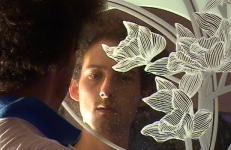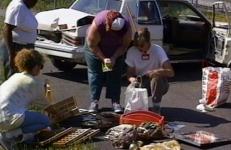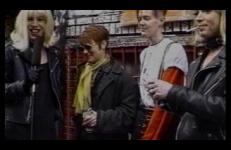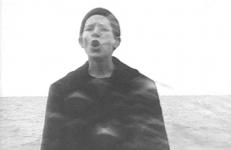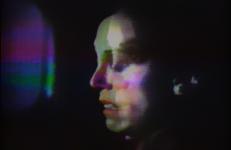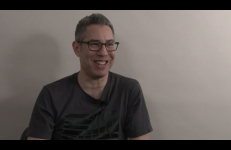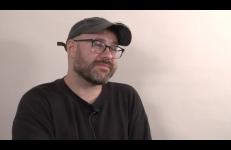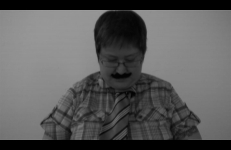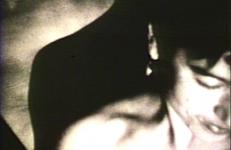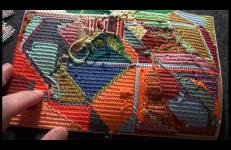A video diary about Cuthand's efforts to undergo artificial insemination. Cuthand contemplates a desire to have children and its relation to preserving Indigenous culture.
Gender
New to the 2 Spirit lifestyle? `Want to talk to someone in the Spirit and the Flesh instead of reading The Spirit and the Flesh? We have just the service for you! Call now and for only 19.99 a month you can get instant unlimited telephone access to traditional knowledge and support. We also provide monthly gifts for subscribers, call now and we can hook you up with this beaded whisk! Perfect for DIY spankings and pancakes the morning after your first snag!
In 50 Blue a young man (the artist’s brother) pushes an elderly disabled man (the artist’s father) in a wheel chair through a muddy landscape. It is a long and exhausting trip to an unknown destination only discovered at the end. After an arduous struggle the two arrive at the edge of a grey lake where a 10-meter high guard tower stands. The young man ties the wheel chair to a rope and hoists the old man up on the tower platform with the help of eight men, all dressed in yellow plastic raincoats.
In A Case for the Closet, Glennda Orgasm and Judy LaBruce host an episode of Closet Talk. They discuss why they are for people staying in the closet, and attribute coming out of the closet to the mediocrity, and thus downfall, of gay culture. Glennda and Judy establish their new movement, XXX Gay (replacing the postqueer movement), and explain its philosphies and values.
This music video for the band Julie Ruin, fronted by Kathleen Hanna, formerly of Bikini Kill, critiques the cynical music marketeers of corporate America. Criticism particularly targets campaigns aimed at women, which Benning and Hanna refer to here as the "Girls Rule (kind of) Strategy."
This music video for the band Julie Ruin, fronted by Kathleen Hanna, formerly of Bikini Kill, critiques the cynical music marketeers of corporate America. Criticism particularly targets campaigns aimed at women, which Benning and Hanna refer to here as the "Girls Rule (kind of) Strategy."
Affected and/or Effected begins with a close-up of a girl resting her head on her hand, reading. On the overlapping track a male voice states “affected,"—followed by a female voice that responds “and/or effected….” This pattern of dividing words in half and presenting them in alternating male and female voices continues throughout the video. While what is seen is separated from what is heard, the boundaries between the audio and video portions of the piece are complicated by other sounds. The statement of intent is spoken: "An artist may construct an art.
Trans filmmaker Jules Rosskam's against a trans narrative is a provocative and personal experimental documentary investigating dominant constructions of trans-masculine identity, gender, and the nature of community.
By sensitively framing the film through his own personal journey within the trans-masculine community, Rosskam creates an electric and original investigation into gender politics and social self-identity.
In this interview, American filmmaker, teacher, and video artist Peggy Ahwesh (b.1954) delves into the key figures and primary texts that have inspired her work in Super-8 and video since the 1970s. She discusses her early influences as a member of the underground art scenes in Pittsburgh in the late 70s and Soho’s Kitchen in the 80s. Ahwesh’s experimental hand-processing and controversial subject matter can be traced to feminist theory, and her exposure to underground experimental films, including works by Werner Herzog, George Amaro, Kenneth Anger, Jack Smith and her teacher at Antioch College, Tony Conrad.
Alex and José is a 16mm single channel projection that explores gender, movement and form.
Music: Zeena Parkins
At the heart of Alone With You is the notion of impassioned avarice, i.e. the kind of motivated acquisitiveness that drives both erotic desire and obsessive collecting.
In the video An Evening with Kembra, Glennda and Brenda attend one of Kembra Pfahler's dinner shows on New York City's Lower East Side. At her show, she performs cabaret versions of songs from her band The Volumptuous Horror of Karen Black. After the show, the group discusses the relationship of her work to queer culture. Interspersed throughout the video are two short clips: a skit entitled Drag Queen Starter Kit, and a call to boycott a bakery due to its discriminatory behavior.
Androgina is a stand-alone work excerpted from Generic Video Art. "Generics" is the name applied to no-name foods and household items that began appearing in grocery stores during the recession of the 1970s. When novels were added to the collection of genre products, entitled "Western," "Romance," "Adventure," etc., it was from this phenomenon that the initial idea for Generic Video Art arose.
Woman, monster, animal? A portrait of a woman's face, the movement slowed down and reversed, the grotesquely made-up face examined in close-up.
Masked men prowling in the bushes and not touching anything but satin, dandelions and flesh.
Ascensor is an exploration of grief, longing and mysticism through a queer lens. It documents a syncretic ritual that culls from the magical reverberations in Mexican culture to process the unexpected loss of a dear friend. The repetition of the ritual eventually leads to the transcendence of physical space, transforming unrelenting ache into shining resilience.
This project on family violence, spanned two years and several sites across the country, and involved wrecked cars in sculptural installations. The cars were reconfigured by women and children who suffered violence at the hands of loved ones. Linked to each other through common experience, women from a domestic violence shelter in Pittsburgh, a family violence program at Bedford Hills prison, children from shelters in Niagara Falls and Cleveland, teenage girls in Oakland, and politicians on Staten Island all collaborated in making the cars.
In Bad Grrrls, Glennda and Fonda LaBruce attend a Riot Grrrl conference on New York’s Lower East Side. At the conference, they conduct interviews with punk women, performers and artists, including Penny Arcade and Sadie Benning. In doing so, Glennda and Fonda navigate a range of perspectives on feminism, punk, and underground activism. Furthermore, they engage with questions of drag’s relationship with feminism, and how one would reconcile the problems of punk with Riot Grrrl’s desire for women’s liberation.
The image comes up suddenly and then continues unwavering: a young person (Mirra) dressed in a black watchcap and pea coat stands at the edge of a large body of water and sings a sea shanty, occasionally flinching to emphasize certain lyrics or fend off the steady drizzle of rain. The frame is broken up into simple shapes—sea, sky, hat, face, coat—and the longer Mirra sings, the more rain collects on the lens of the camera—threatening to obliterate the subject into the background of sea and sky.
In this angry answer to the expectations advertising culture places on women and their bodies, Tanaka deftly edits commercial images and sound-bite slogans to underscore the message such images carry: that women exist to please men, as wives, mothers, and lovers. Tanaka balances such mainstream images with black and white footage of herself lying naked next to her own doubled image, rejecting the mainstream model of female sexuality that regularly consists of seductive glances and suggestive poses arranged and pre-ordained for the male gaze of the spectator.
Glenn Belverio is an independent filmmaker and drag artist who lives and works in New York City. In 1990, he began producing and co-hosting the popular Manhattan Cable series The Brenda and Glennda Show, a talk show that mixed activism with comedy as it took drag out of the clubs and onto the street. In 1993, the show became Glennda and Friends, a post-queer task show featuring provocative co-starts such as gay pornographer Bruce LaBruce and guerrilla scholar Camille Paglia.
Zach Blas is an artist, writer, and filmmaker whose practice spans technical investigation, research, conceptualism, performance, and science fiction. Currently a Lecturer in the Department of Visual Cultures at Goldsmiths, University of London, Blas has exhibited internationally, including at the Walker Art Center, Gwangju Biennale, Los Angeles County Museum of Art, and Whitechapel Gallery.
After a long period in life identifying as a Butch Lesbian, Cuthand considers transitioning to male. This experience involved a six month period of his life during which he went by the name Sarain, which he would have been called had he been born a boy, and asking to be called by male pronouns. Complicated by mental health crises, Cuthand found themselves in a mental health group home for women, having to hide their gender dysphoria. After a considerable amount of thought and discussion, Cuthand changed his mind and decided to remain a Butch Lesbian.
A beautifully ambiguous study of the nude in light and movement, this short silent film focuses on the dimly lit bodies of two women shot from Child’s distinctly non-male perspective.
"The title, A Boy Needs A Friend, is both a pathetic plea and just a fact."
– Steve Reinke




